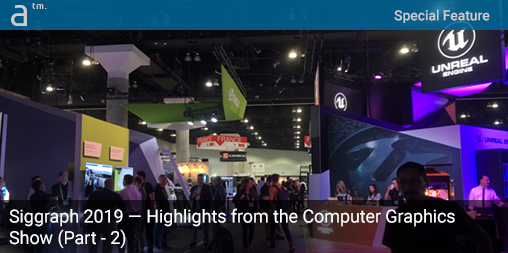Continued from page 1
The Future of 3ds Max
Autodesk’s Nicolas Fonta talked to me in depth about 3DS Max and its future. There is a BETA of BiFrost that will be coming soon. (see video below) In the last year development has been intensifying. Remember the days when there was one major release a year, that has changed because there is a slow release strategy throughout the year to help create a more staple reliable experience and give you a chance to test the features at your pace. Autodesk is listening to you and asks for your feedback on 3DS Max, if there are features you need, problems that you need solved you should join Autodesk Area and look up 3D Max Ideas and submit your ideas.
The viewport is getting faster and more flexible per feedback from users. The viewport can spawn multiple viewports so you can customize for your workflow. There are some things in BETA including a new texture tool with baking revamped. Autodesk is exploring procedural environments in BiFrost. The product team is experimenting with live retargeting and Human IK. 3DS Max is more scalable from 3 artists to even larger sizes and making it easy to do this. 3DS Max announced a partnership with Unity that will make working between 3DS Max easier with data and improve material transport. 3DS Max will support USD and open Material X standard making it easier to work with other applications. This is all good news for those of us doing visualization to know that tools are improving, becoming more universal in Open Source and partnerships mean better stability.
OTOY and Epic Games announced OctaneRender for Unreal Engine 4. It will bring cinematic GPU path-tracing to millions of Unreal Engine artists. This will give architectural visualization a new tool for ray tracing beautiful renders. Artists can now import, export and mix and match ORBX interchange assets from over 2 dozen DCC integrations. Octane Render is fully integrated into Unreal Engine’s 4 node editor—fast auto conversion of Unreal Engine 4 scenes and materials into Octane. A full procedural node based Volumetric Geometry and Lighting for infinite detail. Using OTOY’s ORBX format supports Cinema 4D, Autodesk Maya and 3ds Max and 20+ others.
Blender had a great SIGGRAPH, it has been 20 years since they first were on the show floor. Blender announced RTX support in Blender. This patch was created by Patrick Mours from NVIDIA in close collaboration with Blender Institute. You can now get the insane power of RTX technology inside Blender.
AMD was there to talk about their recent release of Radeon ProRender. ProRender is AMD’s fast, easy and incredible physically based rendering engine that is democratizing rendering. It is available to everyone by leveraging open standards. It is supported by several software packages including Cinema 4D which announced a major update that includes a host of Radeon ProRender features. There is also the first production version of the ProRender for plugin for Blender. Developers have a whole suite of tools available for them with a preview of ProRender’s capabilities.

The Pixar Renderman Art & Science Fair was where we got a sneak peek at what is coming up in Renderman in the near future.
I went to Pixar’s Renderman Art & Science Fair where I got to see a sneak peek at what is coming next for Renderman. Do you remember the scene of the carnival in Toy Story 4, this scene took 17,000 lightbulbs and was rendered using Renderman. This powerful rendering engine is available not just for animation but also VFX and architectural visualization.
USD makes handling huge files with multiple objects and large scenes easier. Hydra delegate is part of Renderman now. Hydra is the imaging framework that ships as part of USD distribution. It connects two or more front ends and backends. Its first and primary back end is a highly scalable OpenGL renderer with multi-pass and OpenSubDiv for mesh renderings. It provides fast preview and animation streaming from USD files. I saw a demo pod featured an iMac Pro running Renderman using USD…it was fast and incredible to see 1200 unique objects on one screen. Can you imagine how useful this will be for complex city design work or even environment visualization?
SIGGRAPH is a big show with the power to overwhelm, but the idea is to find the core key components being discussed like USD, Open XR and RTX and educate yourself more about how these technologies will filter into your life. These technologies are bringing Open Source to the forefront, and changing the industry of visualization, computer animation, and visual effects.
Architecture clients are asking for more Unreal Engine & Unity visualization and the open source solutions can make implementing this easier. I’m hoping that very soon GRAPHISOFT ARCHICAD and Autodesk Revit will also support USD. There is already a Sketchup USD plugin created by Pixar. Pixar makes beautiful movies and now it is becoming a leader in getting open source technology into pipelines to make work easier and these groundbreaking technologies are becoming more universal.

















Reader Comments
Comments for this story are closed